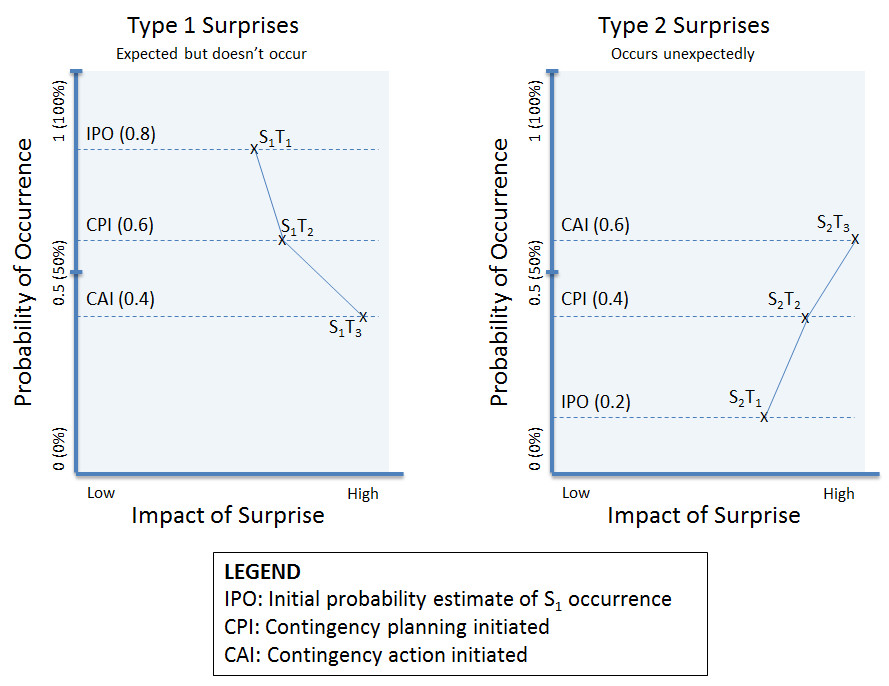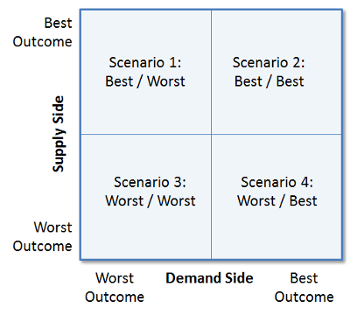In the past 40 years, business has become more complex and, as a consequence, more vulnerable to surprises. Shell Oil was one of the pioneers of pre-emptively managing surprises in the late 1960s. Shell’s anticipation of the 1970s Middle East energy crisis is often claimed to be the foundation for the global competitive edge they maintained for several decades — the crisis was a surprise for the rest of the world, but Shell had prepared for it and was able to respond rapidly. No business could anticipate all surprises through scenario analysis or other procedures — the cost and time required to cover all possibilities would be prohibitive, if it were even possible. The key to responding to surprises is to practice developing contingency plans for selected high impact potential surprises.
IDENTIFY POTENTIAL SURPRISES
In a list of 100 potential surprises that you may be able to identify, the 10% with the highest impact will account for a majority of the total disruption that may be caused by all surprises on the list. Selecting which surprises to focus on when developing scenarios and contingency responses is less important than practicing the ability to respond to surprises as and when they arise. Practicing responding to surprise scenarios is the key; when a surprise unfolds, you want to be well rehearsed in rapidly developing contingency plans and rolling out appropriate responses. This approach to dealing with surprises has characterised successful leadership strategy for thousands of years.
Shell and others selected potential high impact surprises for scenario analysis and contingency planning by using the joint wisdom (gut feel) of their executives supported by input from various think-tanks.
RANK ON IMPACT AND PROBABILITY
Potential surprises are ranked based on their relative disruptive impact and their probability of occurrence. A set of scenarios are developed and contingency plans formulated along the lines suggested below as soon as a negative trending probability pattern emerges for a type 1 surprise (those that were expected but do not occur) or as soon as a positive trending pattern emerges for a type 2 surprise (those that were not expected but do occur).
Figure 1 – Types of Surprises

For a potential surprise that has reached the pre-determined probability threshold, we need to ask the following four questions:
- What is the worst outcome that might be generated for our business’s supply system?
- What is the best outcome that might be generated for our business’s supply system?
- What is the worst outcome that might be generated from our demand system?
- What is the best outcome that might be generated from our demand system?
Using the answers to these questions, four scenarios can be developed (see diagram 2 below). We then focus on developing responses that support the best/best scenario (#2) whilst minimising the potential impact of the worst/worst scenario (#3) – scenarios #1 and #4 can be disregarded, as the best outcome for the business will be secured by pursuing scenario #2 while trying to mitigate scenario #3.
Figure 2 – Extreme Outcome Scenarios for a Surprise

CONTINGENCY STRATEGIES
Contingency strategies that aggressively leverage the best/best outcome opportunities while mitigating potential threats arising from the worst/worst outcome are progressively formulated as the likelihood of the surprise increases. Contingency strategies that were previously developed are activated when a potential surprise reaches the pre-determined probability threshold. If the surprise that emerges has not been previously analysed, the experience gained in pre-empting other surprises will facilitate a rapid strategic response anyway, which helps to secure significant competitive advantage.